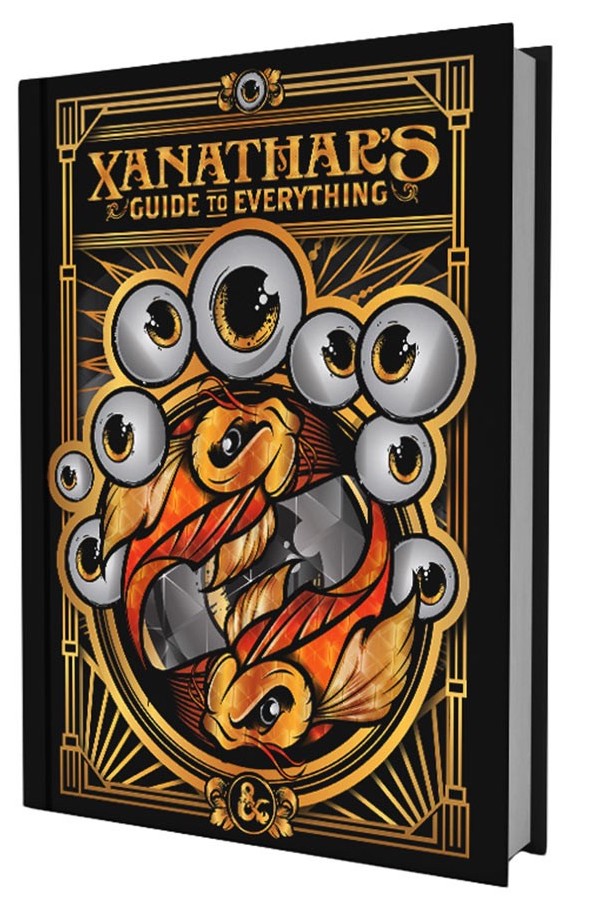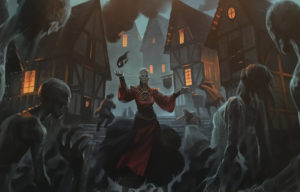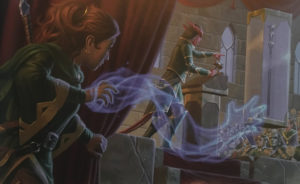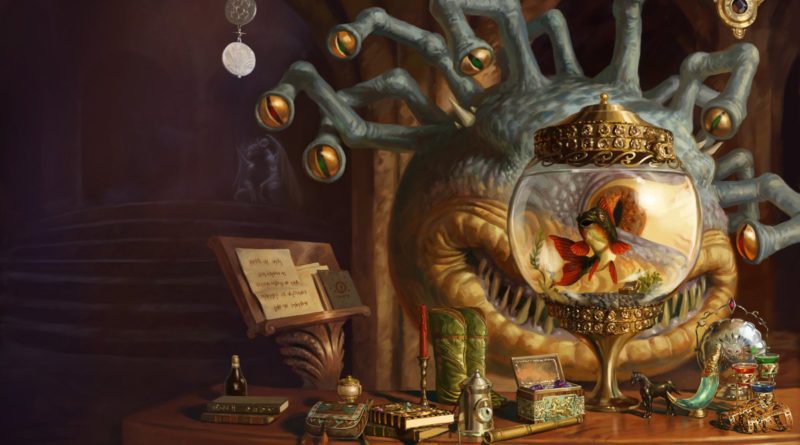RPG Review: Xanathar’s Guide to Everything
Deep below the city of Waterdeep, the Beholder known as Xanathar hold court, seeking knowledge of the entire known multiverse. He has gathered much of this knowledge into the newest release from Wizards of the Coast: Xanathar’s Guide to Everything.
The book is a collection of heavily revised and edited Unearthed Arcana articles, as well as new backgrounds, spells, dungeon master tools and names.
 Let’s talk that cover! If you buy the standard edition, you’ll find the fantastic cover seen above. Xanathar, staring lovingly into the fishbowl of Sylgar, his beloved goldfish. It’s one of the better covers of the new 5e books which have been released. If, however, you can still track down the FLGS-exclusive cover, I highly recommend it. Printed on a beautiful silky-satin, the gold on the book actually shimmers. It’s very evocative, and worth getting it if you can find it. Scour your game shops. If you have seen the alternate art cover of Volo’s Guide to Monsters, you know what I’m talking about.
Let’s talk that cover! If you buy the standard edition, you’ll find the fantastic cover seen above. Xanathar, staring lovingly into the fishbowl of Sylgar, his beloved goldfish. It’s one of the better covers of the new 5e books which have been released. If, however, you can still track down the FLGS-exclusive cover, I highly recommend it. Printed on a beautiful silky-satin, the gold on the book actually shimmers. It’s very evocative, and worth getting it if you can find it. Scour your game shops. If you have seen the alternate art cover of Volo’s Guide to Monsters, you know what I’m talking about.
The introductory page provides a one-page refresher of rules frequently forgotten, or rules that need reiterating. “Exceptions Supersede General Rules” and “Round Down” are good self-explanatory rules to remember, while it goes into detail reminding you how Resistance, Vulnerability, Reaction Timing and Proficiency Bonuses work. All important stuff, and all things that are right there to remind you any time you forget.
The main bulk of the book is character options. Every class, other than the Wizard, gets at least two new options. Wizards get one, which was disappointing, though it’s a good option. I’m never one for min-maxing or aiming for an “optimized” build, or to encourage the same from my players, so I really can’t tell you if the options are the “ideal” for making an effective character, but they all provide really cool ideas.
Each class section provides more detailed Character Background options for your class, going into further and more specific detail of how your character came to find themselves adventuring. They’re all really evocative and I’ll be making it mandatory for all players at my table going forward.
Some of my favorites include the Forge and Grave domains for the Cleric, the Druid’s Circle of Dreams and the Circle of the Shepherd, the Cavalier for the Fighter, and the Ranger Horizon Walker.
The Forge and Grave domains are both very cool. Forge domain is for those clerics who serve artisan gods, and would be ideal for clerics of Deknar from Karthun. They can craft non-magical weapons and armor within an hour in a ritual known as The Artisan’s Blessing. You can also craft duplicate keys or other small items you’d want a copy of, so long as you have an original set on-hand during the ritual. At 6th level, you gain resistance to fire, as well, so it’s a very flavorful class option.
 The Grave domain is great. I played the Unearthed Arcana version of the class for a single session of Curse of Strahd before I had all of my life drained by a spectre in a single critical hit. The Grave domain is great for disciples of The Mother in Karthun, or servants of the Raven Queen. You can sense undead around you (very useful in Ravenloft), can maximize your allies’ hit points when you heal them from 0, can gain Spare the Dying as an extra free cantrip, and can mark enemies for death, making them vulnerable to any attacks you make against them.
The Grave domain is great. I played the Unearthed Arcana version of the class for a single session of Curse of Strahd before I had all of my life drained by a spectre in a single critical hit. The Grave domain is great for disciples of The Mother in Karthun, or servants of the Raven Queen. You can sense undead around you (very useful in Ravenloft), can maximize your allies’ hit points when you heal them from 0, can gain Spare the Dying as an extra free cantrip, and can mark enemies for death, making them vulnerable to any attacks you make against them.
The Circle of Dreams for Druids is very cool and mystical, allowing you to, at 14th level, actually create a teleportation circle into the dream world, which is really cool. Before that level, your character can create circles of magical protection to allow for easier rest for your allies, and tap into the power of the Summer Court to heal your allies. It’s a really flavorful subclass, and you could easily create a whole personality around a Circle of Dreams druid.
The Circle of the Shepherd grants a druid the ability to speak Sylvan and communicate with all beasts at 2nd level, and allows you to bolster the creatures you summon. You also gain a spirit totem, kind of like a barbarian (without the rage). It’s really useful for those Druids who want to focus on summoning and becoming one with the creatures of the forest.
The Fighter’s Cavalier is the ultimate mounted knight. Kind of useless if you end up in a dungeon (those low ceilings make it hard to maneuver a horse inside of), but if you’re playing a primarily outdoor adventure, you are a beast on horseback. You only spend 5 feet of movement to mount a horse rather than half your move, you get advantage to keep from falling off your horse, and you get all kinds of other abilities while on horseback to make you terrifying to face off against. Side note, I just thought of playing as a halfling cavalier riding a dog, and that would be perfect for a dungeon environment and now I want to play that.
The Horizon Walker for the Ranger guards the realms against planar threats, gaining misty step and teleportation circle, as well as being able to detect planar portals. By 11th level you can teleport 10 feet every single time you attack. If you have multiple attacks, you teleport each time between those attacks, and if you attack two enemies, you get a bonus attack against a third. If you play as an Eladrin, there’s never a time you aren’t teleporting, which I love the idea of.
There are of course tons of other class options, but those are the ones I liked best.
 The book has a great selection of racial feats as well, such as giving Dragonborn a light version of a dragon’s Frightful Presence abilities, or Wood Elf Magic, which gives you Druid spells no matter your class. They all mostly seem pretty useful. The High Elf’s Fey Teleportation pairs well with the Horizon Walker.
The book has a great selection of racial feats as well, such as giving Dragonborn a light version of a dragon’s Frightful Presence abilities, or Wood Elf Magic, which gives you Druid spells no matter your class. They all mostly seem pretty useful. The High Elf’s Fey Teleportation pairs well with the Horizon Walker.
The Dungeon Master’s Tools section has further rules for falling and sleep, tying knots, tool proficiencies, and spellcasting. Basically, questions that players have presented the designers that they felt needed more detail. There are also more robust rules for encounter building, giving great guidelines for matching CR up to character levels, breaking down numbers of monsters vs. the players, and things like that. It’s really, really invaluable. Random encounters are also provided, with lots of tables to roll on to see what you stumble upon depending on the environment the players are in.
More advanced rules for trapbuilding as well as new types of traps are included, which are very useful because there really weren’t too many available in the Dungeon Master’s Guide, and I always like dropping traps on my players.
Downtime rules are expanded on as well, with a ton of options for players. It’s useful for throwing at your players to give them things to do between adventures, or give them something to do while, perhaps, some of the rest of the group heads off to do some important things in the city while the rest of the party would normally sit around.
This review is getting really long!
The book also contains a bunch of new magical items, new spells for all spell-casting classes, and a massive table of random names, which you might want to photocopy and have in front of you so you look like you know the names of all your NPCs at any given time.
Wow, Xanathar’s Guide is essential for any D&D table. If you are a player or a DM, you should pick this up. I could definitely see at least a few copies of this floating around any table. While I’ve been running Star Trek Adventures lately, I’m tempted to get a D&D game going again just to get to use this.
Christmas is only a few days away. If someone’s looking for a last minute gift for you, or if you’re looking for a gift for the gamer in your life, go get this book now.
Wizards of the Coast provided Dice Monkey a copy of Xanathar’s Guide to Everything for review.

